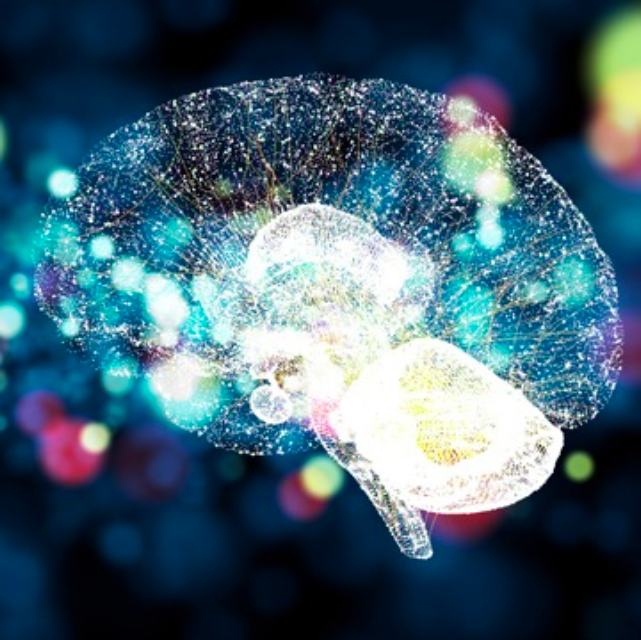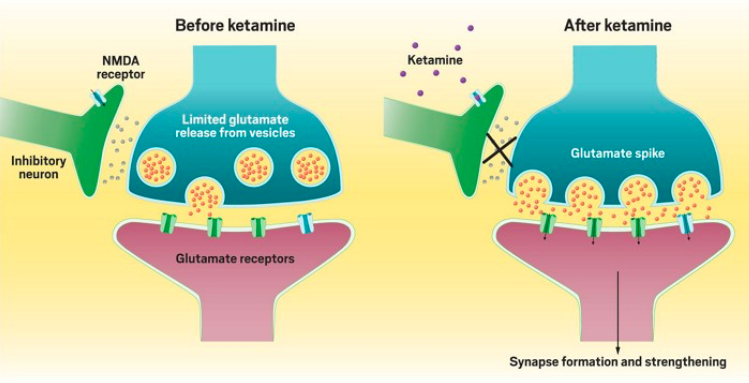
“I feel as if my brain was just totally cleaned out, and I can see clearly for the first time in a long time.”
(A client in a recent Ketamine Assisted Psychotherapy session)
Why ketamine?
For almost 20 years, the anesthetic ketamine, also known as the party drug “special K,” has piqued curiosity in psychiatry, and rightly so. Over time, research has shown that ketamine alleviates depression in only a few hours. This rapid action is in stark contrast to existing antidepressants that normally take weeks to begin working, which matters greatly when dealing with someone who is actively suicidal from the pain and despair of constant depression.
Upon further research, it’s been shown that ketamine helps people who have “treatment-resistant depression,” which means they have tried 2 or more oral antidepressant medications that do not sufficiently reduce their symptoms. About one third of people being treated for depression do not respond to traditional antidepressants, and after years of use, their effectiveness can also diminish. Ketamine is a cutting-edge therapy that works very differently from other antidepressants, by repairing damaged connections and pathways caused by a depressed brain.
Ketamine has been used safely as an anesthetic in medical settings world-wide for decades. In March 2019, ketamine was approved by the U.S. FDA for the treatment of depression in adults who have treatment-resistant depression. Given that the World Health Organization depression reports that depression has now surpassed HIV, AIDS, malaria, diabetes, and war as the leading cause of disability, the increasing use of ketamine is changing the face of mental health treatment in a big way.
Despite this enthusiasm for ketamine, researchers are still not 100% sure how ketamine works its magic. Research on animals has shown that it stimulates the regrowth of synapses and effectively rewires the brain, but the exact way and reason for this is still being discovered.
Who can benefit from ketamine?
In terms of it's use for mental health disorders, ketamine has only “off label” use, meaning it has never been approved to treat any psychiatric conditions. This has led The American Psychiatric Association to be skeptical of its use. In spite of this, more and more psychiatrists and therapists are witnessing its benefits in treating the following
- Treatment Resistant Depression
- Post-Traumatic Stress Disorder
- Suicidal patients
- Anxiety Disorder
- Bipolar Disorder, Depressed
- Bipolar II Disorder
- Obsessive Compulsive Disorder
- Supporting reduction and elimination of psychotropic medications
Further research needs to be done for the following:
- Eating Disorders, like bulimia and anorexia
- Substance and alcohol abuse disorders
- Personality Disorders
- Depression with psychotic features
- Schizoaffective Disorder
- Adjustment Disorders and Acute Stress Disorders
- Unresolved Bereavement
- Emotional complications of chronic medical conditions, like Lyme Spectrum Disorder, cancer, Chronic Fatigue and Fibromyalgia
- Alternative to maintenance ECT
How ketamine works in the brain
The brain has naturally occurring chemical messengers called neurotransmitters, that send electrical information between the neurons by crossing a synapse. Because the electrical signals are not able to cross the gap between most neurons, they are changed into these chemical signals, or neurotransmitters, to cross the gap.
When a person becomes depressed, certain neurotransmitters such as serotonin and dopamine become dysregulated. Neuropathways, which are the routes along which neurotransmitters travel in the brain, become damaged or shut down completely, making it difficult for neurotransmitters to do their job in certain areas of the brain. This interrupts the normal functioning of the brain which leads to changes in behavior, emotion, and cognition. The body actually begins changing the mind.
This is where ketamine therapy can help to change brain structure, and thus help to restore the mind to greater clarity, rather than seeing through the lens of depression.![]() The unique action of ketamine is that it works in the glutamate system of the brain, whereas most traditional antidepressant medications primarily work in the serotonin and dopamine systems. Because glutamate is the brain’s most abundant excitatory neurotransmitter, this enables ketamine to reach previously unaccessed regions of the brain, thus alleviating the symptoms of depression.
The unique action of ketamine is that it works in the glutamate system of the brain, whereas most traditional antidepressant medications primarily work in the serotonin and dopamine systems. Because glutamate is the brain’s most abundant excitatory neurotransmitter, this enables ketamine to reach previously unaccessed regions of the brain, thus alleviating the symptoms of depression.
Glutamate is considered the workhorse of the brain in that it is constantly relaying fleeting thoughts and feelings, and even enables the formation of memories by strengthening synaptic connections. It keeps us “sharp,” and is the reason we don’t forget how to ride a bike even after years. Too much glutamate activity can cause problems as well, and abnormalities in glutamate receptors are linked to a many psychiatric illnesses, including depression and schizophrenia.
Scientists now know that ketamine triggers a gush of glutamate in the brain’s prefrontal cortex, the part of the brain that governs attention and plays an important role in emotional regulation.
There is a paradox to ketamine’s actions on the brain however. Research has shown that ketamine relieves depression by blocking NMDA, a glutamate receptor. Since glutamate is an excitatory neurotransmitter, making neurons more active, more communicative and more likely to form new connections, logic would suggest that blocking its receptor and depriving neurons of excitatory signals, would make the brain even more sluggish, thus increasing symptoms of depression. Instead, it makes neural activity stronger and awakens the brain.

How ketamine helps heal the brain?
When a person has experienced trauma, is chronically stressed and anxious or chronically depressed, the brain is flooded with a stress hormone, cortisol, which reduces the brain's plasticity and operation.
In fact, stress can actually cause both depression and PTSD, by releasing to much or too little cortisol. In unipolar depression, the brain is constantly flooded with cortisol, and in people with PTSD, it is often that not enough cortisol may have been released during the traumatic event. This results in a loss of synapses, or connection points between neurons.
Ketamine treatment can actually clear excess cortisol and “reset” the brain, helping the brain to create new connections.![]() Patients report increased clarity in thinking, creativity, and a sense of calm.
Patients report increased clarity in thinking, creativity, and a sense of calm.
Ketamine itself is not a cure for depression, but can help accelerate the healing process of the brain, and at the same time relieve the often debilitating effects of depression.
In many ways, the full mechanism by which subanesthetic doses of ketamine induce such therapeutic effects remains a mystery. A study from 2015 demonstrated that the antidepressant effects of ketamine are based on the release of BDNF.
BDNF is a protein that is released during aerobic exercise, and has been called miracle grow for the brain. It acts as a neuron fertilizer, promoting the grown of new neurons (neurogenesis) and increasing the functional connectivity between regions of the brain, by increasing neuroplasticity. It is common knowledge that exercise increases cognitive functioning and reduces the risk for anxiety, depression and dementia.
You could say that ketamine can help your brain transform from a forest with little growth and lots of debris, to a lush and vibrant forest again.
How ketamine effects the default control network (DMN)
The default mode network refers to an interconnected group of brain regions that are associated with introspective functions, internally directed thought, such as self-reflection, and self-criticism.
It’s been found that there is increased DMN activity and functional connectivity in people with depression and pain disorders. There is often excessive rumination of repetitive thoughts, and a replaying of sad or traumatic memories over and over in the mind. This prevents healing and growing into more positive experiences and emotions.
This circular and overactive thinking in the DMN leads to feelings of being trapped and wanting to flee, often in the form of suicidal ideation. It’s been shown that even after one session of ketamine, suicidal ideation is dramatically decreased in many people.
Reducing activity in the DMN can decrease rumination, which in turn can reduce pain and depressed feelings. Ketamine reduces the functional activity in the DMN! This reduction in DMN activity functions as a kind of “rebooting” of the brain, releasing the mind from the rigorous control of the DMN. It is this effect of ketamine and other psychedelics that allows for what is experienced as an opening in the person’s ability to see with new eyes.![]()
The potent benefits of Ketamine’s therapeutic use
Recent research has shown that the rapid reduction in depression symptoms from ketamine is directly related to its dissociative effects. This can be confusing, because dissociation is also often a symptom of PTSD. In the case of a safely guided ketamine experience, these dissociative effects allow for a pause in the habitual thought process, and a welcomed feeling of distance between the person and their depression or trauma. This opens up a window in the mind to new possibilities, including a fresh view of life’s challenges and unbearable sorrows.
The powerful psychedelic effect of ketamine at higher doses can facilitate a profound mystical or peak experience. This allows a person to experience the transpersonal dimension, beyond the biological, biographical, and psychological realms, as well as what many people express as the cosmic or galactic realms, depending upon their orientation. When a therapist is both comfortable and trained to explore these realms with clients, deep emotional and spiritual healing can take place.
These peak experiences are consciousness expanding, rather than consciousness contracting as are most other medications, in terms of the person’s sense of self and comprehension of existence. This mind expansion opens up a space for deep healing, where a person can feel their own essence rather than the burden of their depression or anxiety. Often people speak of feeling a lightness as their true Self emerges.
In order for a person to experience this expansion of consciousness, the conditioned boundaries of the ego and the defenses constructed to protect it must dissolve—the release of the control of the DMN— which is what creates the opening. There is both an energy transfer in the brain itself, and an alteration of perception in the mind. Ketamine is a very potent dual catalyst of a physiological and psychospiritual transformation.![]()
Core emotional themes may emerge in these expanded states. Ketamine can also be empathogenic or heart opening in lower doses, similar to MDMA, commonly known as Ecstasy. The usual defenses and inhibitions are relaxed and released, and when this is experienced in the context of a relationship with a skilled psychotherapist, insight, resolution and deep healing is possible.
Ways of delivering ketamine
There are two forms of ketamine being delivered at this time:
-
Racemic ketamine, which s a mixture of two mirror-image molecules: “R” and “S” ketamine. While it was approved decades ago as an anesthetic by the FDA, its off-label use is what treats depression.
-
Esketamine (Spravato), https://www.fda.gov/news-events/press- announcements/fda-approves-new-nasal-spray-medication-treatment- resistant-depression-available-only-certified which the FDA approved in 2019 is given as a nasal spray. It uses only the “S” molecule
A much lower dose of ketamine is given for depression compared with the dose necessary for anesthesia. Like opioids, ketamine has addictive properties, which must be considered for anyone struggling with addiction. You can know if one was addicted to it if they are showing signs of ketamine withdrawal symptoms.
Beyond it’s use and misuse as a street drug, there are several modes of delivering ketamine. The most popular and known method to date is the IV Infusion method, and thousands of IV ketamine clinics have appeared on the scene in the past few years. Of course, as with all things, there are articles touting the benefits and the drawbacks. I have personally witnessed several clients benefit immensely from this treatment.
When IV ketamine works, people usually respond to it within one to three infusions. If a person has no response at all, further infusions are unlikely to help. People who experience some relief from depression within one to three ketamine treatments are probably likely to extend these positive effects if the treatment is repeated several more times, prolonging the effects rather than achieving further significant relief. At this time, there are not standard guidelines, but most studies indicated eight treatments during an acute phase, often using the esketamine nasal spray in between sessions. There is also the IM or intramuscular mode of delivery, and studies have shown that both IV and IM are equally effective.
Ketamine treatment is non-linear treatment process and individual responses vary widely. The literature indicates a 70% response rate to ketamine, and a remission rate for patients with treatment-resistant depression of 40-50% with multiple sessions. Since relapses do occur, a person may require periodic additional sessions. It’s been shown that combining ketamine with intensive psychotherapy enhances response rates.
The third method of delivery, Ketamine Assisted Psychotherapy (KAP) is an innovative treatment approach that combines ketamine administration in a safe and supportive set and setting with inner-directed and supportive psychotherapy and ongoing integration.
Combining ketamine with psychotherapy can yield a greater benefit than biological ketamine treatments alone.![]() The non-ordinary consciousness states of the ketamine experience provide more material to work with in therapy, especially in the context of a long-term psychotherapeutic relationship.
The non-ordinary consciousness states of the ketamine experience provide more material to work with in therapy, especially in the context of a long-term psychotherapeutic relationship.
In this mode of delivery, the client has a thorough psychological and physical screening by the therapist and a physician, and the oral ketamine losenges are mailed to the client from a compounding pharmacy. The client then brings the losenges to the to the psychotherapy office, and the KAP trained therapist guides the client through the journey, usually using music to enhance the process. This approach focuses on the comfort of the client and creating a soothing environment that maximizes the therapeutic effect of treatment.
If the client has another psychotherapist, coordination of care is essential. Ketamine is not a standalone treatment, and one of the most important factors in optimizing its effectiveness is steady support and reflective integration of the experience. By processing at every stage of treatment, the effects of the ketamine are deepened and amplified.
Contraindications and potential misuse
A thorough screening is essential on both the psychological and physical level if a person is to be treated with ketamine delivered in any form.
The following conditions are disqualifying:
-
Pregnant women and nursing mothers
-
Poorly controlled or untreated hypertension and other cardiovascular problem
-
Poorly controlled or untreated hyperthyroidism
-
Acute Mania/Hypomania
-
History of psychosis or schizophrenia
-
Allergy to ketamine or past addiction to ketamine
-
Recent Traumatic Brain Injury (check out Las Vegas best injury attorneys here)
-
Severe Obstructive Sleep Apnea or Respiratory Disease
-
Obesity >300#
-
An ongoing substance abuse disorder or addiction
-
History of bladder or cystitis
Ketamine is a Schedule III drug, which means it is approved for medical and clinical use and requires a prescription. Drugs are classified as Schedule III if they are designed for medical use but have a risk of dependence. In the case of ketamine, the risk of physical dependence is low to medium. However, the risk of developing psychological dependence is very high.
Ketamine is a remarkably safe medicine when delivered in the proper dose in the proper way in the proper setting. It’s used as an anesthetic in children. But as in all things on this planet of duality, there is the dark side of ketamine. It relieves pain in a way similar to opioids, and is readily available at a cheap rate on the streets.
Overdoses on ketamine alone are rare, but does happen, and usually involves mixing the drug with another substance like alcohol. And unfortunately, due to its sedating effects, ketamine has also become known as a date rape drug.
Personal experience as psychotherapist and patient
I became very aware of ketamine in 2019, when a client who could not take any other medications had become severely suicidal. I told her about ketamine, and she immediately went to a local infusion clinic for several treatments. At the time, I knew of no other method of delivery, other than as party drug that caused people to go into a k-hole.
My client’s suicidal ideation was lifted immediately, and she has continued to be depression free since then. To her credit, she did a great deal of deep work in psychotherapy after the ketamine treatments, with all her emotions available.
I wondered if this innovated medicine could help my daughter who had been struggling with severe depression and anxiety for quite a while. She had reached a point in her own therapy where she needed some relief to continue on. She did a course of 6 IV ketamine sessions over a 3 week period, and was able to get off all her other medications.
I was now really curious and hopeful, as the mounting anxieties in my clients due to the pandemic, and the rising mental health crisis became more evident every day. For 30 years, I have used alternative methods such as psychodrama, brainspotting, breathwork and somatic psychotherapy to help clients. In fact, it’s been a personal quest of mine to continue to learn new ways to help people heal from depression and anxiety, which I believe is rooted in trauma.
I decided to try the IV sessions myself, as I was now referring people. I found the sessions to be so very powerful, even after years of deep process work, but I had no one to process any of it with. The ego dissolution I experienced during a very difficult time in my life was profound, and something I could handle, having had a great deal of experience with other psychedelics in my life. But I wondered how the experience would be if I had not already done a lot of personal growth work.
I had a friend take me to the last 2 sessions of 4 and remain with me, which was both comforting and helpful. I realized immediately that this medicine could revolutionize the treatment of depression and other mental health issues, if it could be combined with psychotherapy.![]()
I began to research and found some literature on Ketamine Assisted Psychotherapy (KAP), I saw that the West Coast was filled with KAP practitioners, but very few were available in my own state of Virginia. I began my training immediately. Now that I have begun to offer KAP sessions, clients are having profoundly healing experiences during the sessions, and continue to integrate the new awareness into their lives.
Ketamine is not a panacea, magic bullet, or free ticket to personal transformation. Rather, I see ketamine as a gift of modern science at a time when we need new medicines, and innovative practitioners who are trained to work with clients in non-ordinary states of consciousness. I am deeply grateful for what this medicine has already provided in my life. It is part of the inspiration to become more outspoken about the power of psychedelics to alleviate suffering and awaken consciousness in human beings.



I had a stroke in Feb. 2019. As a yoga teacher, my stroke broke my connections to postures and their associated names. And I could not bring out words which describe the postures. Really tough bringing it all together. I’ve worked with other yoga teachers and flash cards and readings , and videos bringing all back. Slowly
but I’ve been teaching and learning all over again. I feel good with my progress.
Anyway, I definitely wonder if KAP., could have assisted my recovery.
I think it could have Tom. It’s very good medicine for the brain.